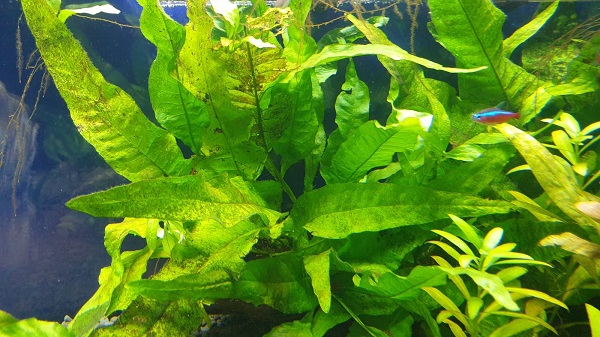What are the Different Types of Aquarium and Pond Plants?
Fish tanks look attractive in the presence of live plants. Plastic plants seem beautiful & do not need maintenance. Fish can’t eat plastic plants. But it isn’t the best solution because fish need a natural environment that mimics their wild habitat so it is very important to introduce live plants. They have benefits such as they encourage certain fish species to spawn. They lay eggs on plant leaves. Also, fish & shrimps eat them. Fish fries feed on live plants & plantation provides hiding spots for fries & stressed fish. Many fish like to rest on the leaves of the plants & use them as shelters.
The most important advantage of keeping aquatic plants is that they release oxygen & absorb CO2 & ammonia that aquarium inhabitants release. Fish breathe oxygen for survival & if your aquarium has high levels of ammonia, your fish may die.
Aquarium plants have adapted to live in fish tanks. Certain species of aquatic plants grow similar to ordinary land plants while other species grow differently. You can purchase aquarium plants from fish stores or nurseries. A lot of people grow them in gardens or pots. It can be kept indoor or outdoor depending on its light requirements. Many people add non aquarium plants in their tanks & then they find out that their plants are not doing well. Non aquatic plants either die, cultivate at slow speed or have a shorter life span when grown in unnatural conditions.
Aquarium plants fall into 4 main categories depending on the nature & tolerance to water for example certain plants can survive when fully submerged in water while other plants have their roots inside water but they are growing outside.
- Emergent Aquatic Plants
- Submerged Aquatic Plants
- Floating Leaved Aquatic Plants
- Free Floating Aquatic Plants
1. Emergent Aquarium Plants:
Emergent aquarium plants cultivate in shadow regions. They are rigid plants & can keep themselves in place because they are rooted in the aquarium substrate (or fixed at the bottom of water), but their leaves & stem are growing above the surface of water. In the wild, emergent plants cultivate in shallow regions such as along the banks, where the depth of water is around 4 to 5 feet. Emergent plants require direct sunlight or tank lights. They can only cultivate when their top part is kept above the surface of water. Their leaves must receive either direct sunlight / tank lights for better photosynthesis & it is only possible when the plant leaves are above water. Emergent plants need lots of water for cultivation so they grow well in water.
Emergent aquarium plants are also called emersed aquatic plants. Following plants can grow emersed:
- Kleiner Bar
- Ozelot
- Rubin
- Uruguayensis
- Cordata
- Wendtii
- Undulata
- Wendtii (Red)
- Crispis
- Boivinianu
- Bacopa caroliniana
- lindernia grandiflora
2. Submerged Aquarium Plants:
Submerged aquarium plants grow fully inside water & they are rooted in the tank substrate (or fixed at the bottom of water). Water is needed for supporting the plant structure. Most of Emergent plant vegetation is in water. It is possible that some part of submerged plants grows above the water surface.
Submerged plants absorb toxic chemicals. Many fish feed on submerged aquarium plants. Bottom dwelling fish make shelters in the plants. They release oxygen & absorb carbon dioxide in the presence of light. Many fish deposit eggs on submerged plants & take care of the babies.
Submerged aquarium plants are usually easy to keep. Their main requirement is high intensity tank lights that can reach the bottom of the aquarium. Plants need lights for photosynthesis. If water is dirty then light will not be able to reach the bottom of the aquarium so keep water clean. Maintain the ideal temperature & pH to help plants grow well.
Submerged plants can grow emersed too if they are not trimmed. Submerged plants when they get taller, then their top part will grow outside water, & they will form shoots, grow leaves & flowers above the water surface. However, they will stop light from reaching the lower leaves & will stop photosynthesis. If not trimmed frequently, the lower part of the plant will die. So submerged plants need frequent pruning to allow lights to reach lower leaves.
Submerged aquatic plants are also known as immersed aquatic plants. Following plants can grow submerged & emersed:
- Java Moss
- Monte Carlo
- Dwarf Hairgrass
- Anubias
- Ludwigia
- Rotala Rotundifolia
3. Floating Leaved Aquarium Plants:
Floating Leaved aquarium plants are rooted in the aquarium substrate & their leaves float on the surface of water. Their roots are normally buried in the gravels or fixed at the bottom of water, & they absorb nutrients from the water. Few floating leaved plants are a bit rigid & they grow slightly above the water surface.
They have flat leaves for receiving high intensity of direct sunlight / tank lights for efficient photosynthesis.
Floating leaved aquatic plants include:
- Waterlilies
- Lotus
- Watershield
- Spatterdock
4. Free Floating Aquarium Plants:
Free floating aquarium plants grow on the surface of water & they are not rooted in the aquarium substrate. They are not fixed & air can blow them.
They cultivate similar to ordinary plants. They can achieve height & develop seeds for growing more plants. They have lower needs as compared to other plants & can be simply grown in fish tanks.
Certain floating aquatic plants can also grow submerged. Following plants can grow free floating & submerged:
- Floating Plants
- Ludwigia
- Green Pennywort
- Java Fern
- Watercress
- Water Wisteria


Post a Comment